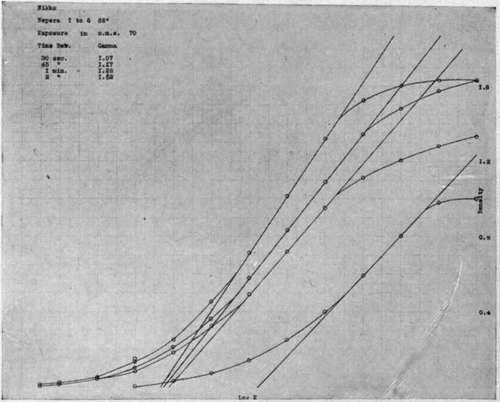Paper Prints
Description
This section is from the book "Airplane Photography", by Herbert E. Ives. Also available from Amazon: Airplane photography.
Paper Prints
Prints on paper suffer by compariscn with transparencies, in the range of tones which they exhibit. This lies between the white of the paper, which never has more than 80 per cent, reflecting power, and its darkest black, which differs with the kind of paper. In dull or mat papers the blacks will reflect as much as 5 per cent.; in glossy papers, ordinarily used for aerial negatives, the reflection from the black may be as low as one per cent., but in order to get the benefit of this the paper must be so held as not to reflect any bright object to the eyes. This deficiency in the range of paper gradations is not so serious with aerial negatives as with ordinary properly exposed negatives because of the small range of brightness in the aerial view.
The sensitometry of papers is similar to that of plates, with the difference that reflecting powers take the place of transparency. As in the case of transparency emulsions there is in papers no dominating requirement for extreme speed, to which other characteristics must be subordinated. Yet speed is of sufficent importance in handling large quantities of prints so that serial negative printing for military purposes has been done almost entirely on the rapid enlarging papers, rather than on the true contact printing papers, which are slower.
The two principal types of rapid enlarging papers, the bromide and the "gas light," exhibit certain characteristic differences which are important to bear in mind in seeking to obtain any particular quality of print. Bromide papers, of which "Nikko" is a good example, show sensitometric curves rather like those of plates. That is, they increase in contrast with continued development. At the same time, as is shown in Fig. 110, they increase somewhat in speed with development; that is, under exposure can be compensated for to a small degree by protracted development. These characteristics of bromide paper can be utilized to secure prints of a quality quite different from that of the negative. Thus, if the negative has a long range of tones, a flat print can be secured by full exposure and short development. If, as is apt to be the case with aerial negatives, a print of greater contrast than the negative is desired, a short exposure with long development is called for.

Fig. 110. - Characteristic curves of bromide paper.
The sensitometric curves of a typical gas light paper "Contrast Enlarging Cyco," are shown in Fig. 111. Here the contrast is a fixed characteristic of the paper, and the only effect of changing development is on the speed; that is, exposure and development are, within limits, interchangeable.

Fig. 111. - Characteristic curves of gas-light paper.
Choosing a printing paper is a matter of deciding on the contrast required for the class of negative, and selecting a paper which will give this contrast with a good range of tones from a clear white to a deep black. The ideal paper would be one which was all straight line in the H & D plot. In such a paper there would occur no loss of contrast in the lighter tones when the high-lights were rendered by the clear white of the paper. Too great contrast with a short straight line portion, results in loss of detail at the ends of the scale. A negative possessing a very great range of tones cannot be correctly represented on one paper print—two printings are required, one for high-lights and one for shadows, but this difficulty is rarely to be faced in aerial views. The greatest demand for aerial printing papers has been for those of considerable contrast, because of the flat character of the negatives.
Continue to:
- prev: Transparencies
- Table of Contents
- next: Chapter XXII. Photographic Chemicals. General Considerations
Tags
camera, lens, airplane, aerial, film, exposure, photography, maps, birdseye
